英语从高考题看with的复合结构
从高考题谈with的复合结构
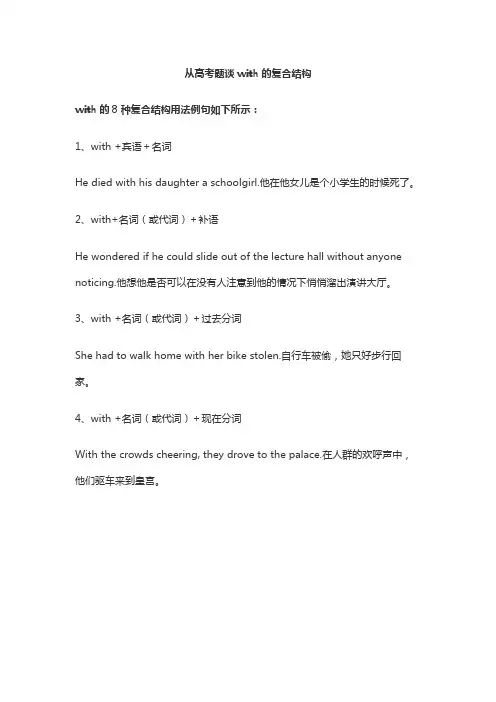
从高考题谈with的复合结构with的8种复合结构用法例句如下所示:1、with +宾语+名词He died with his daughter a schoolgirl.他在他女儿是个小学生的时候死了。
2、with+名词(或代词)+补语He wondered if he could slide out of the lecture hall without anyone noticing.他想他是否可以在没有人注意到他的情况下悄悄溜出演讲大厅。
3、with +名词(或代词)+过去分词She had to walk home with her bike stolen.自行车被偷,她只好步行回家。
4、with +名词(或代词)+现在分词With the crowds cheering, they drove to the palace.在人群的欢呼声中,他们驱车来到皇宫。
5、with+名词(或代词)+非谓语动词With a lot of work to do, he wasn't allowed to go out.因为还有很多工作要做,他没有被允许外出。
6、with+名词(或代词)+介词短语He walked into the dark street with a stick in his hand.他走进黑暗的街道时手里拿着根棍子。
7、with+名词(或代词)+副词She left the room with all the lights on.她离开了房间,灯还亮着。
8、with+名词(或代词)+形容词I like to sleep with the windows open.我喜欢把窗户开着睡觉。
高三英语独立主格结构with的复合结构试题答案及解析
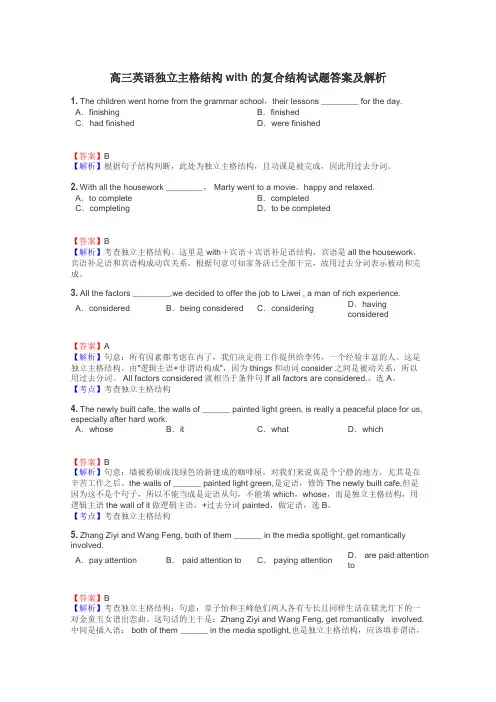
高三英语独立主格结构with的复合结构试题答案及解析1. The children went home from the grammar school,their lessons ________ for the day. A.finishing B.finishedC.had finished D.were finished【答案】B【解析】根据句子结构判断,此处为独立主格结构,且功课是被完成,因此用过去分词。
2. With all the housework ________, Marty went to a movie,happy and relaxed.A.to complete B.completedC.completing D.to be completed【答案】B【解析】考查独立主格结构。
这里是with+宾语+宾语补足语结构,宾语是all the housework,宾语补足语和宾语构成动宾关系,根据句意可知家务活已全部干完,故用过去分词表示被动和完成。
3. All the factors ________,we decided to offer the job to Liwei , a man of rich experience.A.considered B.being considered C.considering D.having considered【答案】A【解析】句意:所有因素都考虑在内了,我们决定将工作提供给李伟,一个经验丰富的人。
这是独立主格结构。
由“逻辑主语+非谓语构成”,因为things和动词consider之间是被动关系,所以用过去分词。
All factors considered就相当于条件句If all factors are considered.,选A。
【考点】考查独立主格结构4. The newly built cafe, the walls of ______ painted light green, is really a peaceful place for us, especially after hard work.A.whose B.it C.what D.which【答案】B【解析】句意:墙被粉刷成浅绿色的新建成的咖啡屋,对我们来说真是个宁静的地方,尤其是在辛苦工作之后。
With的复合结构
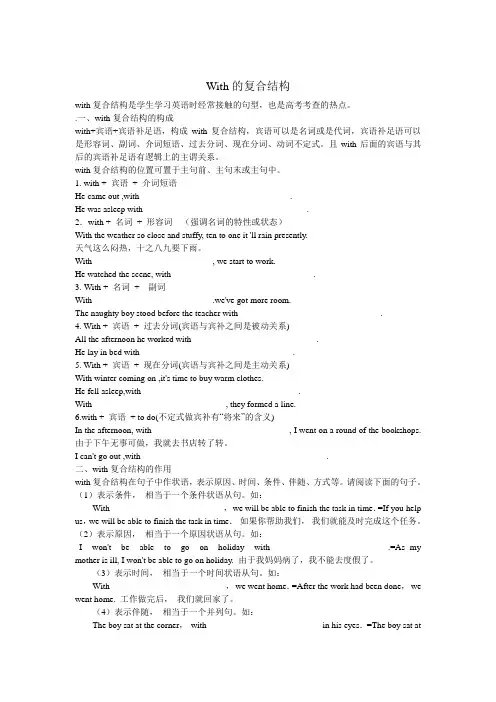
With的复合结构with复合结构是学生学习英语时经常接触的句型,也是高考考查的热点。
.一、with复合结构的构成with+宾语+宾语补足语,构成with复合结构,宾语可以是名词或是代词,宾语补足语可以是形容词、副词、介词短语、过去分词、现在分词、动词不定式。
且with后面的宾语与其后的宾语补足语有逻辑上的主谓关系。
with复合结构的位置可置于主句前、主句末或主句中。
1. with + 宾语+ 介词短语He came out ,with __________________________________.He was asleep with _____________________________________.2.with + 名词+ 形容词(强调名词的特性或状态)With the weather so close and stuffy, ten to one it 'll rain presently.天气这么闷热,十之八九要下雨。
With ___________________________, we start to work.He watched the scene, with ________________________________.3.With + 名词+ 副词With ___________________________.we've got more room.The naughty boy stood before the teacher with ________________________________.4. With + 宾语+ 过去分词(宾语与宾补之间是被动关系)All the afternoon he worked with ____________________________.He lay in bed with___________________________________.5. With + 宾语+ 现在分词(宾语与宾补之间是主动关系)With winter coming on ,it's time to buy warm clothes.He fell asleep,with____________________________________.With ______________________________, they formed a line.6.with + 宾语+ to do(不定式做宾补有“将来”的含义)In the afternoon, with _______________________________, I went on a round of the bookshops. 由于下午无事可做,我就去书店转了转。
with复合结构在高考中的用法
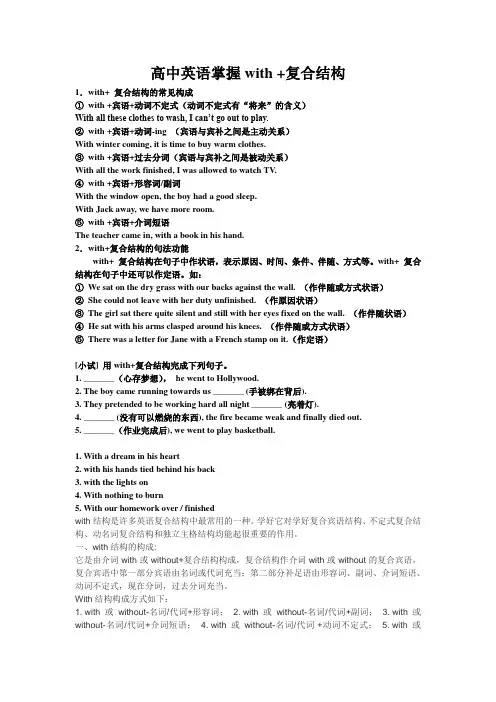
高中英语掌握with +复合结构1.with+ 复合结构的常见构成①with +宾语+动词不定式(动词不定式有“将来”的含义)With all these clothes to wash, I can’t go out to play.②with +宾语+动词-ing (宾语与宾补之间是主动关系)With winter coming, it is time to buy warm clothes.③with +宾语+过去分词(宾语与宾补之间是被动关系)With all the work finished, I was allowed to watch TV.④with +宾语+形容词/副词With the window open, the boy had a good sleep.With Jack away, we have more room.⑤with +宾语+介词短语The teacher came in, with a book in his hand.2.with+复合结构的句法功能with+ 复合结构在句子中作状语,表示原因、时间、条件、伴随、方式等。
with+ 复合结构在句子中还可以作定语。
如:①We sat on the dry grass with our backs against the wall. (作伴随或方式状语)②She could not leave with her duty unfinished. (作原因状语)③The girl sat there quite silent and still with her eyes fixed on the wall. (作伴随状语)④He sat with his arms clasped around his knees. (作伴随或方式状语)⑤There was a letter for Jane with a French stamp on it.(作定语)[小试] 用with+复合结构完成下列句子。
英语中with复合结构在高考中的用法
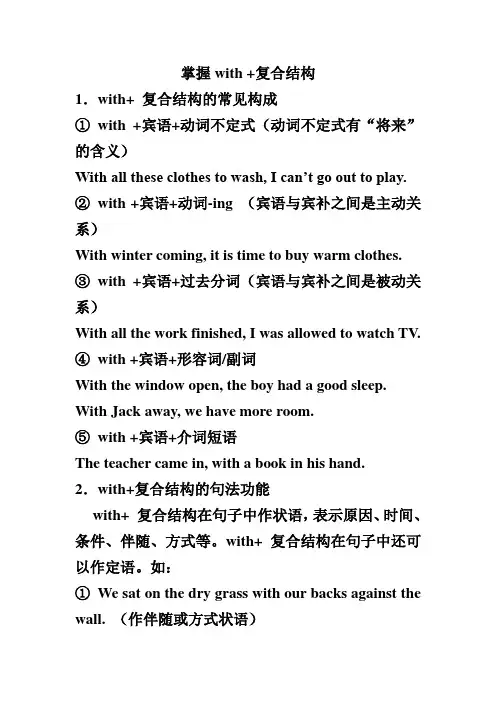
掌握with +复合结构1.with+ 复合结构的常见构成①with +宾语+动词不定式(动词不定式有“将来”的含义)With all these clothes to wash, I can’t go out to play.②with +宾语+动词-ing (宾语与宾补之间是主动关系)With winter coming, it is time to buy warm clothes.③with +宾语+过去分词(宾语与宾补之间是被动关系)With all the work finished, I was allowed to watch TV.④with +宾语+形容词/副词With the window open, the boy had a good sleep.With Jack away, we have more room.⑤with +宾语+介词短语The teacher came in, with a book in his hand.2.with+复合结构的句法功能with+ 复合结构在句子中作状语,表示原因、时间、条件、伴随、方式等。
with+ 复合结构在句子中还可以作定语。
如:①We sat on the dry grass with our backs against the wall. (作伴随或方式状语)②She could not leave with her duty unfinished. (作原因状语)③The girl sat there quite silent and still with her eyes fixed on the wall. (作伴随状语)④He sat with his arms clasped around his knees. (作伴随或方式状语)⑤There was a letter for Jane with a French stamp on it.(作定语)[小试] 用with+复合结构完成下列句子。
高考英语难点解析1---with复合结构的常见形式
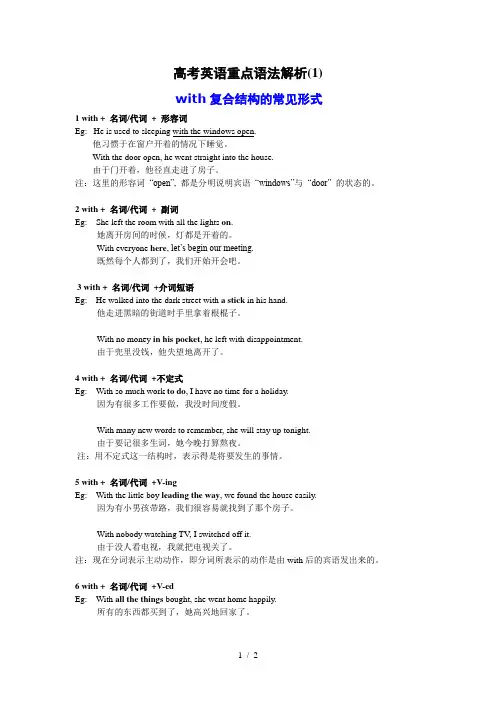
高考英语重点语法解析(1)with复合结构的常见形式1 with + 名词/代词+ 形容词Eg: He is used to sleeping with the windows open.他习惯于在窗户开着的情况下睡觉。
With the door open, he went straight into the house.由于门开着,他径直走进了房子。
注:这里的形容词“open”, 都是分明说明宾语“windows”与“door” 的状态的。
2 with + 名词/代词+ 副词Eg: She left the room with all the lights on.她离开房间的时候,灯都是开着的。
With everyone here, let’s begin our meeting.既然每个人都到了,我们开始开会吧。
3 with + 名词/代词+介词短语Eg: He walked into the dark street with a stick in his hand.他走进黑暗的街道时手里拿着根棍子。
With no money in his pocket, he left with disappointment.由于兜里没钱,他失望地离开了。
4 with + 名词/代词+不定式Eg: With so much work to do, I have no time for a holiday.因为有很多工作要做,我没时间度假。
With many new words to remember, she will stay up tonight.由于要记很多生词,她今晚打算熬夜。
注:用不定式这一结构时,表示得是将要发生的事情。
5 with + 名词/代词+V-ingEg: With the little boy leading the way, we found the house easily.因为有小男孩带路,我们很容易就找到了那个房子。
with 的复合结构和独立主格结构
1. with+宾语+形容词。
比如:。
The boy wore a shirt with the neck open, showing his bare chest. 那男孩儿穿着一件衬衫,颈部敞开,露出光光的胸膛. Don't talk with your mouth full。
嘴里有食物时不要讲话.2. with+宾语+副词。
比如: She followed the guide with her head down. 她低着头,跟在导游之后。
What a lonely world it will be with you away. 你不在,多没劲儿呀!3. with+宾语+过去分词。
比如: He was listening to the music with his eyes half closed。
他眼睛半闭着听音乐. She sat with her head bent。
她低着头坐着。
4。
with+宾语+现在分词。
比如:With winter coming, it’s time to buy warm clothes。
冬天到了,该买些保暖的衣服了. He soon fell asleep with the light still burning。
他很快就睡着了,(可)灯还亮着. 5. with+宾语+介词短语。
比如:He was asleep with his head on his arms。
他的头枕在臂膀上睡着了。
The young lady came in, with her two- year—old son in her arms. 那位年轻的女士进来了,怀里抱着两岁的孩子。
6。
with+宾语+动词不定式。
比如:With nothing to do in the afternoon, I went to see a film。
下午无事可做,我就去看了场电影。
Sorry, I can’t go out with all these dishes to wash。
高中英语2025届高考读后续写常用with复合结构知识讲解
高考英语读后续写常用with复合结构“with复合结构”即“with+宾语+宾语补足语”,多用作原因状语或伴随状语,起到修饰句子的作用,使句子表达更形象,更生动。
1.with+ n./pron.+to do (表将要)The newly-elected president is having a hard time with a lot ofproblems to settle.有许多问题要解决,新当选的总统正处于水深火热中。
With too much homework to do, I have no time to do what I like to do.有太多家庭作业要做,我没有时间做我喜欢做的事。
With no one to turn to for help, she was in despair.没有人可以寻求帮助,她很绝望。
With no one to talk to, John felt depressed.没有可以说话的人,约翰感到很抑郁。
2.with+n./pron.+-ing分词 (表主动,进行)With time going by, he realized how much his father loved him.随着时间的推移,他意识到了父亲是多么爱他。
The day was bright,with a fresh breeze blowing.阳光明媚,微风和煦。
With the clear moon shining straight overhead,it was nearly as bright as day.皓月当空,明亮如白昼。
With the College Entrance Examination approaching, thestudents devote all their time to preparing for it.随着高考临近,学生们投入所有时间为之准备。
with复合结构
“with复合结构”与“独立主格结构”是学习英语时,经常接触的句型,也是高考考查的热点之一。
一、with复合结构1. with复合结构的构成“with + 宾语+ 宾语补足语”构成with复合结构,宾语可以是名词或代词,宾语补足语可以是现在分词、过去分词、动词不定式、形容词、副词、介词短语等。
1)with + 宾语+ 现在分词(宾语与宾补之间存在逻辑主谓关系,时间上表示进行)The young woman, with a baby sleeping in her arms, was wandering in the street.2)with + 宾语+ 过去分词(宾语与宾补之间存在逻辑动宾关系,时间上表示完成)All the afternoon he worked with the door locked.3)with + 宾语+ to do (宾语与宾补之间存在逻辑主谓关系,时间上表示将来)With so many essays to write, he won’t have time to go shopping this morning.4)with + 宾语+ 介词短语BBC English broadcasts programmes for China with explanations in Chinese.5)with + 宾语+ 形容词/ 副词With the door open, the noise of the machine is almost deafening.The little boy sat in front of the house, with his shoes off.2. with复合结构的作用1)作状语。
with复合结构在句子中作状语,表示原因、时间、条件、伴随、方式等。
With the meeting over, all the representatives left the meeting-room. (表时间)Jack was tired and soon fell asleep with the light still burning. (表伴随)He sat with his arms clasped around his knees. (表方式)2)作定语。
高考英语 with复合结构 新人教
5. with+宾语+介词短语 He sat near the fire with his back to the door. 他坐在炉子旁,背朝着房门。 The teacher came in with a book in his hand. 老师进来了,手里拿着本书。 6. with+宾语+现在分词 With the machine helping us, we could finish the work on time. 由于有机器的帮助,我们能按时完成任务。 She lives in the room with the light burning. 她住在亮着灯的那个房间里。
MOMODA POWERPOINT
Lorem ipsum dolor sit amet, consectetur adipiscing elit. Fusce id urna blandit, eleifend nulla ac, fringilla purus. Nulla iaculis tempor felis ut cursus.
三. with复合结构作状语 表示伴随状况 She left the office with tears in her eyes. 她眼里含着泪,离开了办公室。 He was covered with a national flag with his face exposed. 一面国旗盖在他身上,脸露在外面。
3. 表示时间 The children began to watch TV with the homework done. 孩子们完成作业以后开始看电视。 The meeting was over with the problem settled. 问题解决以后,会议结束了。
- 1、下载文档前请自行甄别文档内容的完整性,平台不提供额外的编辑、内容补充、找答案等附加服务。
- 2、"仅部分预览"的文档,不可在线预览部分如存在完整性等问题,可反馈申请退款(可完整预览的文档不适用该条件!)。
- 3、如文档侵犯您的权益,请联系客服反馈,我们会尽快为您处理(人工客服工作时间:9:00-18:30)。
英语:从高考题看with的复合结构
先看下面两道高考题:
1. ________ production up by 60%, the company has had another excellent year.
A. As
B. For
C. With
D. Through
2. With a lot of difficult problems ________, the newly-elected president is having a hard time.
A. settled
B. settling
C. to settle
D. being settled
【解析】这两题的答案均为C。
with的复合结构在英语中运用广泛,在具体运用中能使表达更为精确,在高考中也是主要考点之一。
现将其用法作一简单总结。
1. with + O (n. / pron.) + OC (prep phrase) 在句中常作定语或状语。
如:
On this important feast day, people might eat food in the shape of skulls, and cakes with “bones”on them.
在这个重要的节庆日子里,人们吃制成颅骨形状的食物和装点有“骨头”的蛋糕。
2. with + O (n. / pron.) + OC (adj.) 在句中常作状语。
如:
They were listening to the teacher with their eyes wide open.
他们睁大眼睛听老师讲课。
3. with + O (n. / pron.) + OC (n.) 在句中作定语或状语。
如:
At the foot of the mountain, there once lived an old man with the name Old Stubborn.
在山脚下,曾住着个名叫“老顽固”的老头儿。
4. with + O (n. / pron.) + OC (doing) 在句中常作状语,doing表示主动或正在进行的动作。
如:
Mary felt shy with the whole class looking at her.
在全班同学的注视下,玛丽感到不好意思。
5. with + O (n. / pron.) + OC (done) 在句中常作状语,done表示被动或完成了的动作。
如:
With the problem settled, we all felt very happy.
问题解决了,我们都非常高兴。
6. with + O (n. / pron.) + OC (to do) 在句中常作状语,to do表示将要发生的动作。
如:
With so much work to do, I can't even make a proper plan.
有这么多事要做,我甚至连恰当的计划都很难做出来。
7. with + O (n. / pron.) + OC (adv.) 在句中常作状语。
如:
With her mother away from home, she felt lonely.
母亲不在家,她感到孤独。
He went out hurriedly in the rain with no umbrella on. 他没拿伞,急匆匆地冲进了雨里。
